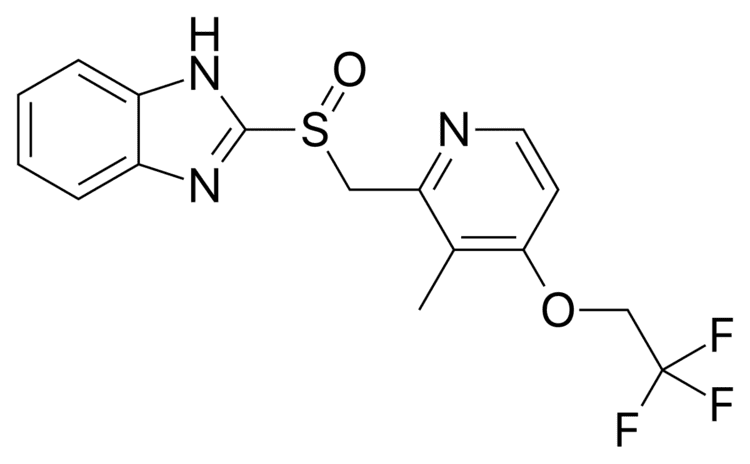Trade names Prevacid, others MedlinePlus a695020 CAS ID 103577-45-3 Protein binding 97% | AHFS/Drugs.com Monograph License data US FDA: Lansoprazole Molar mass 369.363 g/mol | |
 | ||
Pronunciation /lænˈsoʊprəzoʊl/ lan-SOH-prə-zohl Pregnancycategory AU: B3US: B (No risk in non-human studies) | ||
Lansoprazole side effects they rarely happen
Lansoprazole, sold under the brand name Prevacid among others, is a medication which inhibits the stomach's production of acid. There is no evidence that its effectiveness is different from that of other PPIs. Lansoprazole, given through a nasogatric tube, effectively controls pH inside the stomach and is an alternative to intravenous pantoprazole in people who are unable to swallow solid-dose formulations.
Contents
- Lansoprazole side effects they rarely happen
- How to pronounce lansoprazole prevacid memorizing pharmacology flashcard
- Medical uses
- Side effects
- Interactions
- Availability
- Research
- References
Lansoprazole is a proton-pump inhibitor (PPI) in the same pharmacologic class as omeprazole. Lansoprazole has been marketed for many years and is one of several PPIs available. It is a racemic 1:1 mixture of the enantiomers dexlansoprazole (Dexilant, formerly named Kapidex) and levolansoprazole. Dexlansoprazole is an enantiomerically pure active ingredient of a commercial drug as a result of the enantiomeric shift. Lansoprazole's plasma elimination half-life (1.5 h) is not proportional to the duration of the drug's effects to the person (i.e. gastric acid suppression). The effects of the medication last for over 24 hours after it has been used for a day or more.
It is manufactured by a number of companies worldwide under several brand names. In the United States, it was first approved by the Food and Drug Administration (FDA) in 1995. Prevacid patent protection expired on November 10, 2009.
How to pronounce lansoprazole prevacid memorizing pharmacology flashcard
Medical uses
Lansoprazole is used for treatment of:
There is no good evidence that it works better than other PPIs.
Side effects
Side effects of PPIs in general and lansoprazole in particular may include:
PPIs may be associated with a greater risk of hip fractures and Clostridium difficile-associated diarrhea.
Interactions
Lansoprazole interacts with several other drugs, either due to its own nature or as a PPI.
Lansoprazole possibly interacts with, among other drugs:
Availability
The lansoprazole molecule is off-patent and so generic drugs are available under many brand names in many countries; there are patents covering some formulations in effect as of 2015.
Since 2009, lansoprazole has been available over the counter (OTC) in the U.S. in a marketed by Novartis as Prevacid 24HR. In Australia, it is marketed by Pfizer as Zoton.
Research
In vitro experiments have shown that lansoprazole binds to the pathogenic form of tau protein. As of 2015 laboratory studies were underway on analogs of lansoprazole to explore their use as potential PET imaging agents for diagnosing tauopathies including Alzheimer's disease. Lansoprazole is also a prodrug that targets the cytochrome bc1 complex of Mycobacterium tuberculosis once converted to lansoprazole sulfide in mycobacterial host cells.
